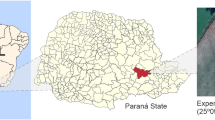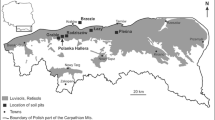Abstract
The composition and physical properties of three clay soils were altered by introducing aluminum under an electro-chemical gradient in order to evaluate the role of pH in controlling changes in soil composition and the feasibility of pH buffering during electrochemical treatment.
Both X-ray diffraction and selective chemical extraction methods were used to determine the distribution and mode of occurrence of aluminum in the treated samples. Aluminum was detected in the treated samples in both exchangeable form and as a hydroxy-aluminum interlayer. Aluminum oxide minerals such as gibbsite were not detected in any of the treated samples. Mineralization by aluminum ions was speeded and intensified in bentonite soils by buffering the catholyte with carbon dioxide.
Plasticity of bentonite soil samples from South Dakota was reduced markedly by electrochemical treatment, whereas the plasticity of an illite soil from Illinois and an illite-montmorillonite soil from Mississippi were relatively unaffected. Nearly all treated samples exhibited some degree of electrochemical induration or mineralization. Induration was most pronounced in bentonite soil samples with high water contents and alkaline pH largely because of hydroxy-aluminum interlayering in the ciay. On the other hand interlayering was negligible in illite soil samples with low pH; the main effect of electrochemical treatment in this case was the addition of aluminum in exchange sites.
Résumé
La composition et les propriétés physiques de trois sols argileux ont été modifiées par l’introduction d’aluminium sous un gradient électrochimique afin de définir le rôle du pH dans le contrôle des changements affectant la composition des sols et la possibilité d’amortir le pH au cours du traitement électrochimique. Les méthodes de diffraction des rayons X et d’extraction chimique sélective ont été utilisées pour déterminer la distribution et le mode d’intervention de l’aluminium dans les prélèvements traités. L’aluminium a été détecté dans les prélèvements traités à la fois sous la forme échangeable et en tant que couche intermédiaire d’hydroxy-aluminium. Les minéraux d’oxyde d’aluminium tel que le gibbsite n’ont été détectés dans aucun des échantillons traités. La minéralisation par les ions d’aluminium a été activée et intensifiée dans les sols de bentonite en amortissant le catholyte avec de l’oxyde de carbone. La plasticité des échantillons de sols de bentonite du Dakota du Sud a été réduite notablement par le traitement électrochimique, tandis que la plasticité d’un sol illite de l’Illinois et un sol illite-montmorillonite du Mississippi n’était pratiquement pas affectée. Presque tous les échantillons traités ont montré quelque degré d’induration électrochimique ou de minéralisation. L’induration était plus prononcée dans les échantillons de sols bentonite avec des teneurs en eau élevées et un pH alcalin surtout à cause des couches intermédiaires d’hydroxy-aluminium dans l’argile. D’autre part la couche intermédiaire était négligeable dans les échantillons de sols illites avec pH faible: le principal effet du traitement électrochimique dans ce cas était l’apport d’aluminium dans les zones d’échange.
Kurzreferat
Die Zusammensetzung und die physikalischen Eigenschaften von drei Ton-Erden wurden durch Einführung von Aluminium unter Steuerung der elektrochemischen Merkmale eingeführt, um die Rolle des pH-Wertes bei der Regelung von Änderungen in der Bodenzusammensetzung und die Möglichkeit einer pH-Pufferung während elektrochemischer Behandlung zu untersuchen.
Sowohl Röntgendiffraktions-als auch selektive chemische Extraktionsmethoden wurden angewandt, um die Verteilung und Erscheinungsform des Aluminiums in den behandelten Proben zu bestimmen. Das Aluminium wurde in den behandelten Proben in sowohl austauschbarer Form als auch als Hydroxy-Aluminium-Zwischenschicht gefunden. Aluminiumoxydminerale wie Gibbsit wurden in keiner der behandelten Proben festgestellt. Die Mineralisierung durch Aluminium-Ionen wurde in Bentonit-Erden durch Pufferung des Kafholyten mit Kohlendioxyd beschleunigt und verstärkt.
Die Plastizität der Bentonit-Erdproben von Süd-Dakota wurde merklich durch elektrochemische Behandlung reduziert, während die Plastizität einer Illit-Erde aus Illinois und einer Illit-Montmoril-lonit-Erde aus Mississippi verhältnismäßig unberührt blieb. Fast alle der behandelten Proben wiesen eine gewisse elektrochemische Verhärtung oder Mineralisierung auf. Die Verhärtung war in Bentonit-Erdproben mit hohem Wassergehalt und alkalischem pH besonders beachtlich, vor allem wegen der Hydroxy-Aluminiumschichtung im Ton. Andererseits war die Schichtung in Illitboden-proben mit niedrigem pH-Wert vernachlässigbar gering. Die Hauptwirkung der elektrochemischen Behandlung bestand in diesem Fall in der Bereicherung der Austauschpunkte mit Aluminium.
Резюме
Состав и физические свойства трех глинистых грунтов оыли изменены добавлением алюминия при электрохимическом градиенте для определения роли рН в контролируемых изменениях состава почвы и возможности буфферного действия на рН электрохимической обработки. Для определения распределения и формы нахождения алюминия в обработанных образцах использованы как дифракция рентгеновских лучей, так и селективные химические вытяжки. Алюминий в обработанных образцах обнаружен как в обменной форме, так и в виде гидроксиалюминиевых межслоевых выделений. Минералы свободной окиси алюминия например гиббсит, ни в одном из обработанных образцов обнаружены не были. Минерали¬зация при участии иона алюминия была ускорена и усилена в бентонитовых грунтах при использовании углекислоты в качестве буфера католита.
Пластичность образцов бентонитового грунта из Южной Дакоты заметно уменьшалась после электрохимической обработки, тогда как пластичность иллитового грунта из Иллинойса и иллито-монтмориллонитового грунта из Миссисипи практически не изменилась.
Почти все обработанные образцы обнаружили некоторую степень химического затверде¬вания или минерализации. Затвердевание было наиболее отчетливым в образцах бентонито¬вого грунта с высоким содержанием воды и щелочной реакцией, в основном благодаря наличию гидрооксиалюминиевых межслоевых выделений в глинистом минерале.В образцах, иллитового грунта с низкими рН межслоевые выделения были весьма незначительными, главным эффектом электрохимической обработки в этом случае было увеличение содержания обменного алюминия.
Similar content being viewed by others
References
Adamson, L. C., Chilingar, G. V., and Armstrong, R. A. (1966) Electrokinetic dewatering, consolidation, and stabilization of soils: Engn. Geor. 1, 291–304.
Barnhisel, R. I., and Rich, C. I. (1965) Gibbsite, bayerite, and nordstrandite formation as affected by anions, pH, and mineral surfaces: Soil Sci. Soc. Am. Proc. 29, 531–534.
Brydon, J. E., and Kodama, H. (1966) The nature of aluminum hydroxide-montmorillonite complexes: Am. Mineralogist 51, 875–889.
Casagrande, L. (1953) Review of past and current work on electro-osmotic stabilization of soils: Harvard Soil Mechanics Series No. 45, Harvard Univ. Press, 135 pp.
Esrig, M. I. (1967) Electrokinetic stabilization of an illitic clay: J. Soil Mech. Found. Div., Am. Soc. Civil Engrs 93, 109–128.
Haglund, H. (1967) Isoelectric focusing in natural pH gradients: LKB Instrument Journal 14, 18–22.
Hsu, Pa Ho, and Bates, T. F. (1964) Formation of X-ray amorphous and crystalline aluminum hydroxides: Mineral Mag. 33, 749–768.
Jackson, M. L. (1965) Free oxides, hydroxides, and amorphous aluminosilicates: Methods of Soil Analysis, (Edited by C. A. Black), Chap. 45. Am. Soc. Agronomy, Madison, 1572 pp.
Jenny, A. (1940) The anodic oxidation of aluminum and its alloys. Chap. 7. Griffin & Co., London, 194 pp.
McAtee, J. L., and Wells, L. M.(1967) Mutual adsorption of clay minerals and colloidal hydrous aluminum oxide -An electron microscopy investigation: J. Colloid Interface Sci. 24, 203–210.
McClean, E. O. (1965) Aluminum analyses: Methods of Soil Analysis, (Edited by C. A. Black), Chap. 6., Am. Soc. Agron., Madison, 1572 pp.
Murayama, S., and Mise, T. (1953) On the electrochemical consolidation of soil using aluminum electrodes: Proc 3rd Intern. Conf. Soil Mech. Found. Eng. Vol. 1, 156–159.
Nettleton, A. F. S. (1960) Physico-chemical relationships of electrochemically strengthened montmorillonite clay mineral: Proc. 3rd Australia-New Zealand Conf. Soil Mech. 59–72.
Shukla, K. P. (1953) Electro-chemical treatment of clays: Proc. 3rd Intern. Conf. Soil Mech. Found. Eng. Vol. 1, 199–202.
Titkov, N. I., Petrov, V. P., and Neretina, A. Ya. (1965) Mineral formation and structure in the electrochemical induration of weak rocks; translation from Russian by Consultants Bureau, New York, 74 pp.
Youell, R. F. (1960) An electrolytic nethod for producing chlorite-like substances from montmorillonite: Clay Minerals Bull. 9, 191–195.
Author information
Authors and Affiliations
Additional information
Publication authorized by the Director, U.S. Geological Survey.
Rights and permissions
About this article
Cite this article
Gray, D.H., Schlocker, J. Electrochemical Alteration of Clay Soils. Clays Clay Miner. 17, 309–322 (1969). https://doi.org/10.1346/CCMN.1969.0170508
Received:
Published:
Issue Date:
DOI: https://doi.org/10.1346/CCMN.1969.0170508




